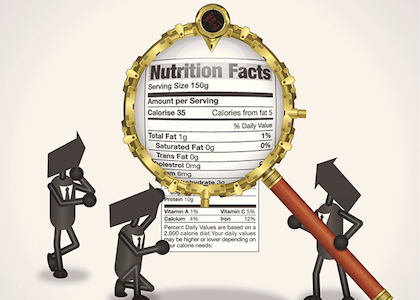
The Smarter Way to Approach Your Next Meal
By Stacy Kennedy, MPH, RD, CSO, LDN; Reboot Nutritionist
A few months back, butter made the cover of Time magazine. This once demonized ingredient thought to be at the root of our drastic rise in heart disease and other illnesses, is in comparison to other culprits, like margarine, being redeemed as not so bad after all. In other words, less of something real is better for you than more (or frankly, any) of something fake.
When choosing what to eat, step one should be looking at the ingredient list.
Most people go straight to the nutrition facts label because we’ve been trained that the grams of protein, sugars, fat and calories are all that truly matter. Think again! “Food first” is something I firmly advocate as a nutritionist. And the only way to know if you’re eating real food is to read the label closely – not just the numbers; the actual ingredients making up the food. Because after all, we don’t eat grams of protein we eat FOODS that have a certain number of grams of protein. Hard to imagine sitting around the dinner table and asking your husband or son to, “please pass 15 grams of protein.”
While the dietary fats (like butter) vs carbs (like sugar) debate rages on, the subject matter is one that is of great interest because it shines light on the evolution of nutrition research.
Nutrition science in our modern way of studying behavior and physiology has only recently emerged. Nutrition research as we know it really took off in the 1990s although certainly science has been studying nutrition for a very long time. Much of the technology and systems needed to truly study how different nutrients, diets, foods, and supplements actually work in our bodies remains in its infancy. This in part explains the frustration of the everyday person, “What do you mean eggs are bad? Now they are good? Bad again? Good???” Same for butter and many other foods.
I’ll admit to enjoying a bit of grass-fed, organic butter on my gluten-free cinnamon raisin bread. (Insert laughing at veggie loving nutritionists here.) People often confess their nutrition digressions to me using language like “admit”, “OK I’ll tell you,” “to tell the truth,” “I’ll fess up”, “you got me.” The reason I hear this is because there is such shame around food choices. And foods themselves are seen as complete black and white, or good or bad, right or wrong, healthy or dangerous. Not much room for basic human experience of good ‘ole boring moderation.
When you sit down to your next meal, keep this in mind…
Keep the quality of the food and the amount or frequency of consumption in consideration to open the doors to enjoy a much wider variety of options once thought to be off the table regarding viable choices within a healthy lifestyle. If you’re sitting at a table that if offering full fat butter or margarine to add flavor to your baked sweet potato, go for the full fat butter but just be cognizant of how much you are adding.
So, enjoy your end of summer holiday BBQs and bring some fresh juice and healthy fruit and veggie based sides and smart sweets to enjoy in abundance. But don’t fret if you have a bite or two of anything that someone else brings like that homemade potato salad or baby back ribs. Just keep moderation in mind, and make sure most of your plate is chockfull of veggies!